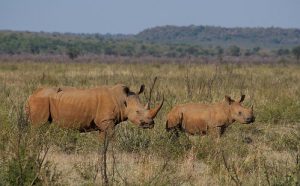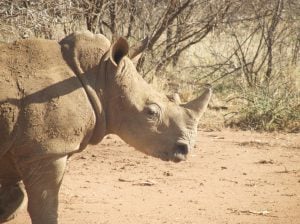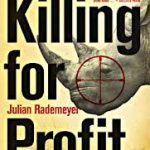Li Zhifei was the unlikely leader of an international crime ring. According to his business card, Li owned a small antique business in Jinan, the capital of China’s Shandong province. It was called “Overseas Treasure Finding” and Li was its treasure hunter. He boasted a small, but exclusive clientele of wealthy men who, for the most part, collected porcelain, bronze and rarities from long-dead dynasties. But there were three of Li’s customers with more illicit tastes. And, for close on two years, he eagerly obliged them.
 On January 30, 2013, Li was arrested in a hotel room in Miami Beach in Florida. A grainy framegrab from a surveillance video (shown, right) shows an earnest, bespectacled and utterly unremarkable man in his late twenties sitting uncomfortably in a chair. He is dwarfed by the oversized television fixed to the wall above his head. A bag is slung over his right shoulder. To his left, on a side table, is wad of cash; about US$60,000 in all. In his hands he holds a rhino horn. Unseen is the undercover federal agent who lured him to the room with the promise of cut-price contraband.
On January 30, 2013, Li was arrested in a hotel room in Miami Beach in Florida. A grainy framegrab from a surveillance video (shown, right) shows an earnest, bespectacled and utterly unremarkable man in his late twenties sitting uncomfortably in a chair. He is dwarfed by the oversized television fixed to the wall above his head. A bag is slung over his right shoulder. To his left, on a side table, is wad of cash; about US$60,000 in all. In his hands he holds a rhino horn. Unseen is the undercover federal agent who lured him to the room with the promise of cut-price contraband.
For some time – as part of a broader investigation into the illegal trade in rhino horn, codenamed Operation Crash – the US Fish and Wildlife Service (USFWS) had been piecing together Li’s movements and business dealings. Li, they later said, had overseen an international “black market network” that had smuggled at least 25 “raw” rhino horns (many from trophies brought back to the US by big game hunters) and a variety of carved ivory and rhino horn objets d’art – worth around US$4.5-million – from the US to China. Three US antique dealers had conspired with Li, buying up “raw horn”, ivory, libation cups and other carvings at his behest. The items would be shipped to Hong Kong, often thickly wrapped in duct-tape to conceal their appearance or hidden in vases or packaged with false customs and shipping documents. From there they were eventually smuggled to China.
It was compelling evidence. So compelling, in fact, that Li waived his rights, confessed and ultimately pleaded guilty to 11 counts of smuggling, wildlife trafficking, falsifying documents and conspiracy (He was sentenced to nearly six years in a US federal penitentiary and ordered to forfeit US$3.5-million of his ill-gotten gains). In a statement, he admitted to paying off customs agents and bribing officials in China to ensure that his contraband went untouched. And he admitted to having contact with three rhino horn buyers in China. One of them, he said, had funded the bulk of his illegal deals. In court papers, the man was referred to only as the “Chinese Buyer”.
He took most of the 25 horns that Li and his co-conspirators smuggled out. In secret workshops, according to Li, the horns were fashioned into ersatz copies of exquisitely carved antiques. Commonly referred to in China as zuo jiu – literally “made old” – the fakes would be shopped to the greedy and the gullible. The off-cuts and shavings from the carving room floor were “salvaged” for sale on the medicinal black markets.
The case against Li and several other suspects arrested since 2012 as part of Operation Crash offers a tantalising glimpse into the shadowy underworld of rhino horn trafficking in China. And elsewhere, in South Africa, Namibia, Mozambique, Hong Kong and Vietnam, other pieces of a disturbing puzzle are beginning to slip into place.
Several months after Li’s arrest, Hong Kong customs officials broke open a shipping container from Nigeria. According to the manifest it contained “Red Cam Processed Wood”. But inside were 21 crates packed with hundreds of elephant tusks, a dozen rhino horns and pieces of leopard skin. The haul was estimated at US$5.3-million. There were no arrests.
In March this year, 11,000 kilometres from Hong Kong in the Namibian capital Windhoek, three Chinese men were arrested as they tried to board a plane at Hosea Kutako International Airport. According to a report in The Namibian newspaper, Li Xiaoliang (30), Li Zhibing (53) and Pu Xunin (49) had tried to smuggle 14 rhino horns and a leopard skin out of the country in their luggage. They later claimed that a Chinese businessman in Zambia had promised them US$3,000 if they delivered the bags to someone in Shanghai. The trio denied any knowledge of the contents of the suitcases.
In South Africa, on May 22, three “high-level” Chinese suspects were arrested on charges of illegal possession and dealing in rhino horn. Those arrests came nearly four months after three other Chinese nationals were arrested and charged with possession of rhino horn and methamphetamine.
In Vietnam evidence has emerged of hidden “factories” in parts of Hanoi where rhino horns are carved into bracelets, bangles and libation cups for Chinese clients. And in China’s Hainan and Yunnan provinces, a company called Long Hui Pharmaceutical is actively engaged in efforts to farm rhinos and harvest their horns with a purpose built “live-suction living rhinoceros horn-scraping tool”.
Together these fragments point to a worrying renewal of Chinese interest in rhino horn, on a scale not seen since the early 1990s.
 Even calves, such as this one pictured above, are killed for the little horn that they have (Image courtesy of Julian Rademeyer/KillingforProfit.com)
Even calves, such as this one pictured above, are killed for the little horn that they have (Image courtesy of Julian Rademeyer/KillingforProfit.com)
China has long been at the heart of the rhino horn trade. Its use of horn for medicine and art dates back 2,000 years. During the Tang Dynasty vast numbers of rhinos were recorded along the Yangtze River. By the 19th century, China’s rhinos had been hunted into extinction. For much of the last century, Chinese mainland, Hong Kong, Taiwan and Singapore dominated the trade in horn from Africa and Asia, supplanted only by Yemen for a brief period during the oil boom of the 1970s. In part the dramatic revival of Traditional Chinese Medicine under Chairman Mao Zedong in the 1950s and 1960s spurred this on. One consequence, according to Esmond Bradley-Martin – one of the world’s leading experts on the rhino horn trade – was “a significant increase in demand for rhino horn in China”. Between 1982 and 1986, long after the 1977 international ban on trade in rhino horn, China imported at least 10 tonnes of it.
Then came a dramatic about-turn. In 1993, after years of international pressure and on the back of embarrassing revelations about its involvement in the black market trade in rhino horn, the Chinese government imposed a blanket prohibition on the sale, importation, exportation and possession of rhino horn. Traders were given six months to dispose of their stock and references to the horn’s medicinal uses were scrubbed from the state-sanctioned TCM pharmacopeia.
TRAFFIC, the wildlife trade monitoring agency, conducted a number of consumer surveys in China in the mid-1990s. The last of them ‒ published in 1996 ‒ found that while a worrying residual black market continued to exist, China had “been highly successful in implementing the domestic ban on rhinoceros horn”.
With the ban came an uneasy quiet. Poaching incidents slowed.
Then, 15 years later in 2008, the slaughter began again. This time the blame fell on Vietnam, a country that had risen from the ashes of war become one of Southeast Asia’s “economic dragons” and a country where the newly rich had acquired not only great wealth but a taste for rare and endangered species.
New poaching records
South Africa, which is home to around 70% of the world’s last remaining rhinos, and countries like Zimbabwe and Kenya bore the brunt of the killing. In six years South Africa lost more than 3,200 rhinos. Compare this to the country’s estimated 19,000-strong rhino population. Each year since 2008 a grisly new poaching record has been set. Last year, just over a thousand animals were killed for their horns in South Africa. So far this year, 631 have been lost. People are dying too. Close to 50 poachers –little more than cannon-fodder for the syndicates that recruit them – were shot and killed in South Africa’s Kruger National Park last year.
More than 4,000 rhino horns, about 12 tonnes worth, are believed to have been smuggled out of Africa between 2009 and 2012. Most of it is believed to have ended up in Vietnam. Only a fraction of the shipments – about 2.3% – were detected and seized by law enforcement officials in Asia.
In Vietnam, the market for rhino horn has changed dramatically over the years. What was once sold as a miracle cure for cancer is now coveted as a symbol of status and power. Some with money to burn even use it as a hangover cure. At up to US$65,000 a kilogram, it doesn’t come cheap.
For some time now, despite overwhelming evidence, the Vietnamese government has been trying to persuade critics that it is not the root of the problem. Last year, the head of the Vietnam’s Cites management authority, said reports describing his country as a “rapacious” consumer of rhino horn were “bullshit”. He claimed that China was the final destination of “99% of the horn that goes through Vietnam”. While this is doubtful, the growing number of smuggling cases involving Chinese nationals suggests that there is a worrying grain of truth to his claim.
But how great is the trade with China? How much horn is being trafficked? And is the horn being used for medicinal purposes or, as the Li case suggests, carved and sold to collectors? And what of Chinese organised crime syndicates? Are they becoming involved in what has proved to be such a lucrative business for kingpins in Vietnam, Laos and Thailand?
In truth, nobody really knows. No surveys have been done of rhino horn use in China since the mid-1990s. Evidence from seizures is limited. Worryingly, the little that is known is largely anecdotal. While high-profile, celebrity-led campaigns to cut consumer demand appear to be making some inroads in China, their broader impact and effectiveness remains unclear.
China is one of the world’s largest consumers of wildlife products ranging from tiger bones and bear bile to pangolins. The slaughter of Africa’s elephants – 33,000 of them a year, at last count – can be laid squarely at its doorstep. No wonder then that conservationists and activists are concerned about its possible impact on the world’s dwindling rhino populations. Even if a fraction of China’s wealthy develop a taste for rhino horn, the consequences will be dire.
At current poaching rates, it is only a matter of time before more rhinos are being killed than are born. When that “tipping point” is reached, the slide is rapid. In the 1960s, there were roughly 100,000 black rhino in Africa. By the time China imposed its ban on trade in 1993, those numbers had fallen as a result of rampant poaching to just over 2,000. Time has run out.







